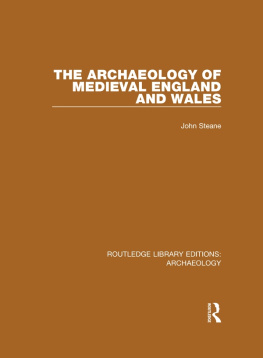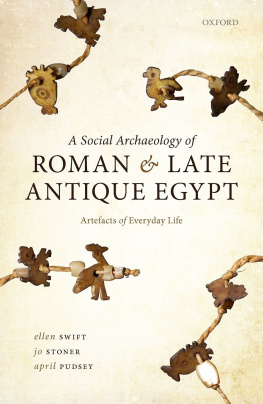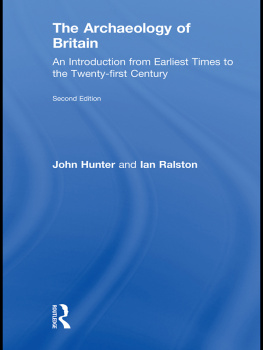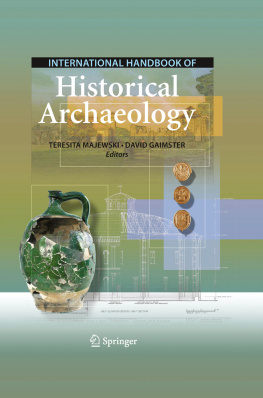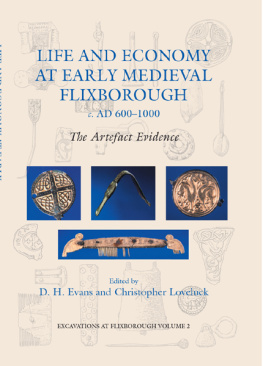ROUTLEDGE LIBRARY EDITIONS:
ARCHAEOLOGY
Volume 47
THE ARCHAEOLOGY OF MEDIEVAL ENGLAND AND WALES
First published in 1985
This edition first published in 2015
by Routledge
2 Park Square, Milton Park, Abingdon, Oxon, OX14 4RN
and by Routledge
711 Third Avenue, New York, NY 10017
Routledge is an imprint of the Taylor & Francis Group, an informa business
1985 John Steane
All rights reserved. No part of this book may be reprinted or reproduced or utilised in any form or by any electronic, mechanical, or other means, now known or hereafter invented, including photocopying and recording, or in any information storage or retrieval system, without permission in writing from the publishers.
Trademark notice: Product or corporate names may be trademarks or registered trademarks, and are used only for identification and explanation without intent to infringe.
British Library Cataloguing in Publication Data
A catalogue record for this book is available from the British Library
ISBN: 978-1-138-79971-4 (Set)
eISBN: 978-1-315-75194-8 (Set)
ISBN: 978-1-138-81508-7 (Volume 47)
eISBN: 978-1-315-74697-5 (Volume 47)
Publishers Note
The publisher has gone to great lengths to ensure the quality of this book but points out that some imperfections from the original may be apparent.
Disclaimer
The publisher has made every effort to trace copyright holders and would welcome correspondence from those they have been unable to trace.
1985 John Steane
Croom Helm Ltd, Provident House, Burrell Row,
Beckenham, Kent BR3 1AT
Croom Helm Australia Pty Ltd, First Floor,
139 King Street, Sydney, NSW 2001, Australia
British Library Cataloguing in Publication Data
Steane, John
The archaeology of medieval England and Wales. (Croom Helm studies in archaeology)
1. Archaeology England 2. England Antiquities I. Title
942.03 DA90
ISBN 0-7099-2385-6
Printed and bound in Great Britain
CONTENTS
My intentions in writing this book were to examine the kind of evidence which recent developments in archaeology have to offer in furthering the study of medieval English and Welsh history. This evidence has accumulated over the last 25 years during an unprece- dentedly extensive burst of archaeological activity. It is of three main kinds: below- ground deposits, above-ground structures and artefacts. During the boom of the late 1960s and 1970s which led to so much central town redevelopment it was the first of these, buried remains, which yielded the most dramatic information. Now that recession has given British archaeologists a breathing space it is being realised that a new look at upstanding remains can yield great profits. The objects too are being submitted to ever more sophisticated study techniques and a comparative approach based on quantified statements is beginning to appear.
The material evidence is, however, only one source for reconstructing the past and many medieval historians would argue that it is not the most valuable or illuminating. There is a danger in their regarding archaeological evidence simply as a source of background or illustrative material used to confirm historical statements which have already been inferred from the documents. This in Sawyers words reduces archaeology to an expensive way of telling us what we know already. In fact, of course, there are myriad aspects which archaeology can illumine from the pre-literate origins of medieval society, the many gaps in the documentary record and in particular the interests of the non record-making classes.
The structure of this book is to take a series of important themes such as Government, Religion, the Countryside, and so on, which are then approached in a roughly chronological way. I have included in the Middle Ages everything from the ninth to the mid-sixteenth century, from the Danish invasions to the Reformation. I was brought up on a battered copy of F.P. Barnards Companion to English History (Middle Ages) (Oxford, 1902), and much well beaten ground which was traversed then I have not attempted to cover again. For information about heraldry, costume, armour, parish church architecture and coinage I would refer readers to Barnard and to A.L. Pooles revision: Medieval England (Oxford, 1958). My approach is that of the field archaeologist, more concerned with the impact of man on the urban and rural landscape. The thread which runs through the book is a technological one how structures were built, how objects were made. My own digging experience is limited largely to rural and industrial sites. Inevitably a good number of my examples of field work are drawn from the areas I know best, the central and southern Midlands. However, I have made rapid forays into East Anglia, the north and the west of the country, and rather longer explorations into Wales.
The people who have helped me most can be divided into four groups: my teachers, fellow archaeologists, the librarians and the typists. My allegiance to the subject of history I owe to the genial influence of Guts Gayford (as we used to call him), Senior History Master at Dulwich. This was reinforced by a powerful dose of medievalism at Magdalen from Bruce McFarlane and Karl Leyser. William Hoskins introduced me to the historical evolution of the English landscape. Max Hoopers lectures on hedgerows and Oliver Rackhams work on woodland made a deep impression on me and I have derived much benefit from the informal gatherings of the Historical Ecology group. An interest in building materials I owe to the geologising of my brother Christopher. Since joining the Oxfordshire Museum Service I have benefited from the friendly encouragement of two directors, Richard Foster and Jim Bateman, and the critical expertise of James Bond, John Rhodes, Ival Hornbrook and Elizabeth Leggatt. My fortnightly discussions with Tom Hassall have been invaluable in providing me with insights into urban archaeology. I am grateful to Philip Page, Richard Chambers, Brian Durham and Maureen Mellor of the Oxford Archaeological Unit for their expenditure of time on my queries. I have also relied heavily on the work of other excavators. Brian Davison of London, Evelyn Baker of Bedford, Brian Dix of Northamptonshire, Martin Petchey, Robert Croft and Paul Woodfield of Buckinghamshire have all put me in touch with developments in their areas. L.S. Colchester has conducted me up the west front and over the high roofs of Wells Cathedral. Among the archaeologists whose books have recently contributed most to my understanding I number Warwick Rodwell, Martin Biddle and Colin Piatt. Piatts masterly synthesis of archaeological investigation and social history, Medieval England (London, 1978) has been a particular inspiration.
I have visited a number of museums in search of illustrative material and have been made welcome by the staff of the British Museum, the Winchester Research Unit, the Museum of London (Brian Spencer), City of Birmingham (David Symons), Bedford (Penny Spencer), Buckinghamshire (Mike Farley), Northampton (Robert Moore), Ashmolean Museum (Arthur McGregor), Museum of Oxford (Dan Chadwick), Winchester (Elizabeth Lewis), Exeter and Dorchester (Dorset). I acknowledge the courtesy and ready provision of a stream of books and articles from the staff of the libraries of the Ashmolean Museum, the Bodleian and Society of Antiquaries, London.
Cynthia Bradfords photographic talents have enhanced the illustrations. I have received generous help with other the Bishop of Winchester, the Bishop of Bath and Wells, and Mr Christie Miller of Clarendon (Wilts.). I am glad to record the ready cooperation of the clerk of works of Salisbury Cathedral, the Bursars of New College, Magdalen College and Lincoln College, Oxford and the Steward of Christ Church College, Oxford who enabled me to visit buildings in their charge.
Next page
